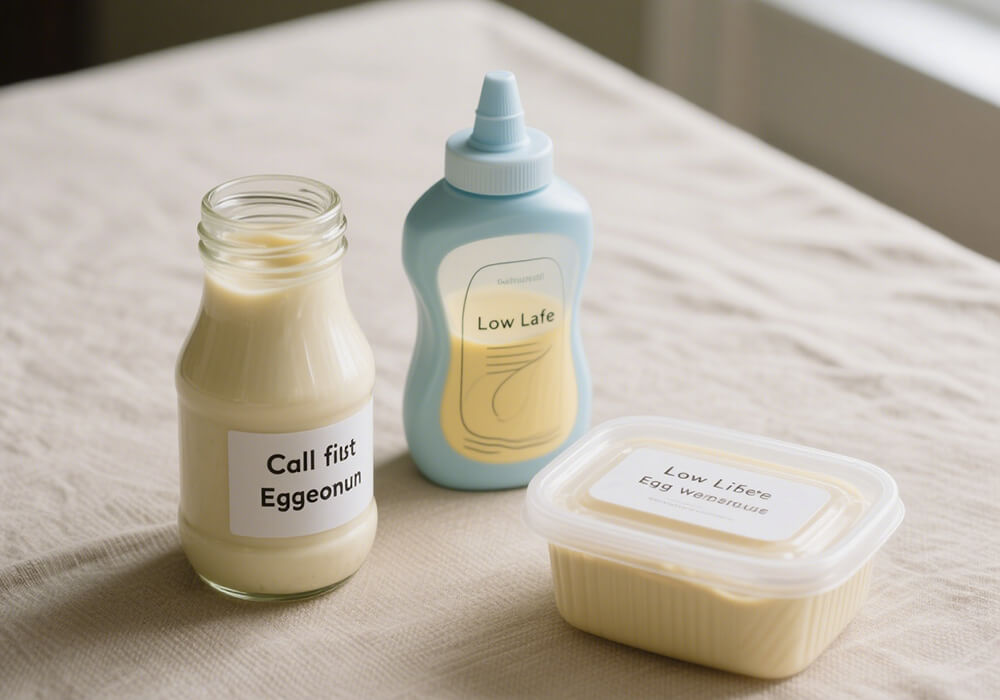
What is Mayonnaise Made Of?
Mayonnaise owes its signature texture and flavor to a simple yet precise blend of core ingredients. At its heart are egg yolks, which act as natural emulsifiers—their unique molecular structure allows them to bind oil and liquid together, preventing separation. Without egg yolks, the mixture would split into distinct layers, losing its creamy consistency entirely.

The primary component by volume is oil, typically making up 70-80% of the condiment. Common choices include neutral vegetable oils like canola, soybean, or sunflower oil, which contribute a mild flavor. Premium or artisanal varieties often use olive oil, adding a fruity or peppery note that enhances the taste. The type of oil directly impacts both the flavor and nutritional profile, though its main role is to create the thick, spreadable texture.
To balance the oil’s richness, an acid is essential—usually vinegar (white, apple cider, or red wine vinegar) or fresh lemon juice. This acid adds a tangy kick that cuts through the oiliness, making the condiment more palatable, and also acts as a natural preservative to extend shelf life.
A small amount of salt is nearly universal, enhancing overall flavor, while some recipes include a pinch of sugar to mellow the acidity. Commercial brands may add stabilizers or preservatives (like calcium disodium EDTA) to maintain freshness, especially in mass-produced versions, but the fundamental trio of egg yolks, oil, and acid remains unchanged across most varieties.
What Nutritional Components Does Mayonnaise Have?
A typical 1-tablespoon (15ml) serving of mayonnaise contains approximately 94 calories, with the majority—about 10 grams—coming from fat. The type of fat depends on the oil used: vegetable oils provide primarily unsaturated fats (monounsaturated and polyunsaturated), which are considered healthier in moderation compared to saturated fats. Olive oil-based mayonnaises, for example, are rich in monounsaturated fats, linked to heart health.

Protein content is minimal, at roughly 0.5 grams per tablespoon, sourced entirely from the egg yolks. These yolks also contribute small amounts of key vitamins and minerals, including vitamin A (supports eye health), vitamin D (aids calcium absorption), vitamin E (an antioxidant), and B vitamins like B12 and folate (critical for energy production and cell function).
Carbohydrates are nearly nonexistent, with less than 1 gram per serving, and sugar content is typically negligible—often under 0.5 grams. Sodium is a notable component, with most commercial brands containing 90-100mg per tablespoon. Low-sodium versions are available, reducing salt by 50% or more, which is beneficial for those monitoring sodium intake.
While mayonnaise contains trace nutrients, it’s important to note that these amounts are too small to contribute significantly to daily nutritional needs. Its primary role remains flavor enhancement rather than nutrition.
How Many Types of Mayonnaise Are There?
Mayonnaise comes in several distinct varieties, each tailored to different dietary preferences and flavor profiles.

Full-fat mayonnaise is the classic iteration, boasting 70-80% fat content. This high fat level delivers a rich, creamy texture and bold flavor, making it ideal for dishes where its taste takes center stage—think potato salad, deviled eggs, or gourmet sandwiches. It’s a favorite among purists who prioritize authenticity and depth of flavor.
Low-fat mayonnaise reduces fat content to 30-50% by replacing oil with water or broth. This creates a lighter consistency, so manufacturers often add thickeners like modified food starch to mimic the creaminess of full-fat versions. The flavor is milder, making it suitable for recipes where mayonnaise plays a supporting role, such as in wraps or light dressings.
Fat-free mayonnaise contains less than 0.5g of fat per serving, using starches, gums, and extra acid to replicate texture. Its taste is noticeably tangier, and it may lack the mouthfeel of traditional mayo, but it appeals to those strictly limiting fat intake.
Olive oil mayonnaise swaps vegetable oil for olive oil, offering a fruity, distinct flavor. Extra virgin olive oil varieties have a robust, peppery taste, while regular olive oil versions are milder. This type is popular among health-conscious consumers due to olive oil’s association with heart health.
Vegan mayonnaise eliminates eggs entirely, using aquafaba (liquid from canned chickpeas), soy protein, or pea protein as emulsifiers. It mirrors the texture of traditional mayo and is a staple for plant-based diets.
Flavored varieties, such as garlic, sriracha, or herb-infused mayonnaise, add extra dimension, while organic options use organic ingredients and avoid synthetic additives.
What Are the Benefits of Mayonnaise for the Body?
When consumed in moderation, mayonnaise offers several unexpected benefits.

The unsaturated fats in many varieties—especially those made with olive oil or sunflower oil—support heart health by helping lower LDL (“bad”) cholesterol levels when replacing saturated fats in the diet. These fats also aid in the absorption of fat-soluble vitamins (A, D, E, K) from other foods, which are critical for immune function, bone health, and cell repair.
Egg yolks in traditional mayonnaise are a source of choline, a nutrient essential for brain health. Choline supports memory, mood regulation, and fetal brain development during pregnancy, making even small amounts of mayonnaise a useful addition to a balanced diet for expectant mothers.
Lutein and zeaxanthin, antioxidants found in egg yolks, promote eye health by reducing the risk of age-related macular degeneration and cataracts. These compounds accumulate in the eyes, protecting them from harmful blue light and oxidative damage.
Mayonnaise can also encourage consumption of nutrient-dense foods: a dollop added to raw vegetables or leafy greens can make these healthy options more appealing, increasing intake of fiber, vitamins, and minerals.
The acid (vinegar or lemon juice) in mayonnaise has mild antimicrobial properties, helping preserve dishes like coleslaw or tuna salad when stored properly, reducing food waste and extending freshness.
Does Mayonnaise Help with Weight Loss?
Mayonnaise is generally not considered a weight loss-friendly food, primarily due to its high calorie and fat content. A single tablespoon contains 90-100 calories, with nearly all calories coming from fat—9 calories per gram, compared to 4 calories per gram for protein and carbohydrates. This calorie density means even small portions can quickly add up, making it hard to maintain a calorie deficit, which is essential for weight loss.

Low-fat mayonnaise, with 30-50 calories per tablespoon, is often marketed as a better option, but it has drawbacks. To compensate for reduced fat, manufacturers often add thickeners, sugar, or extra salt, which don’t enhance satiety. This can leave you feeling less full, leading to increased overall food intake that negates calorie savings.
Another issue is how mayonnaise is typically consumed: paired with high-calorie foods like burgers, fries, or creamy salads. A burger with two tablespoons of mayonnaise, for example, adds 180-200 calories—equivalent to a small meal—without providing meaningful nutrition or lasting fullness.
That said, mayonnaise isn’t inherently “bad.” It can fit into a weight loss plan if used sparingly. Opt for 1 teaspoon (30-35 calories) of regular or low-fat mayo, and pair it with nutrient-dense foods like vegetables, lean proteins, or whole grains. This way, you add flavor without derailing calorie goals.
In short, mayonnaise doesn’t aid weight loss, but moderate portions can be part of a balanced diet—just be mindful of total calorie intake.
Making homemade mayonnaise is simple, allowing you to control ingredients and avoid preservatives. Here’s a foolproof recipe:

Ingredients: 2 large egg yolks (room temperature—critical for emulsification), 1 cup neutral oil (canola or sunflower), 1 tablespoon lemon juice or white vinegar, ½ teaspoon salt, pinch of sugar (optional, to balance tang).
Step 1: In a medium bowl, whisk egg yolks, salt, sugar (if using), and acid vigorously for 30 seconds until thick and pale yellow. This activates the emulsifiers in the yolks, preparing them to bind oil.
Step 2: Add oil extremely slowly—start with 2-3 drops at a time, whisking constantly. Rushing this step causes separation, as yolks can’t bind oil quickly. Continue adding small amounts of oil, whisking nonstop, until the mixture thickens enough to hold a whisk trail (1-2 minutes).
Step 3: Once thickened, pour oil in a thin, steady stream while whisking. Keep going until all oil is incorporated; the mayo will be thick, creamy, and mound slightly when scooped. This takes 3-4 minutes.
Step 4: Taste and adjust: add more salt, acid, or a splash of water if too thick. Transfer to an airtight container.
Store in the refrigerator for 3-4 days (no preservatives). For safety, use pasteurized egg yolks. Customize with garlic, herbs, or Dijon mustard for flavor variations—blend these into the yolk mixture before adding oil.
Pro tip: If the mixture splits, whisk a new egg yolk in a clean bowl, then slowly add the split mayo while whisking—it will re-emulsify.
What is the Shelf Life of Mayonnaise, and How to Store It Effectively?
Mayonnaise’s shelf life depends on type and storage.

Unopened commercial mayonnaise, pasteurized and preserved, lasts 2-3 months beyond its “best by” date. Store in a cool pantry (60-70°F/15-21°C) away from heat or sunlight—heat causes oil to go rancid, ruining texture and flavor. Keep the container sealed to prevent moisture absorption.
Once opened, commercial mayo requires refrigeration. Stored at 40°F (4°C) or below, it stays fresh for 2-3 months. Avoid the fridge door, where temperature fluctuates with frequent opening; instead, place it on a back shelf for consistent cold.
Homemade mayonnaise, lacking preservatives and containing raw eggs, has a much shorter life: 3-4 days in the fridge. Label it with the make date to track freshness, and never leave it unrefrigerated for more than 2 hours.
Signs of spoilage include a sour/rancid smell, darker color, liquid separation, or mold. Discard immediately if any are present—risk of foodborne illness is high.
When serving mayo at gatherings, keep it chilled on ice to stay below 40°F. Never leave it at room temperature for over 2 hours (1 hour above 90°F/32°C), as bacteria thrive in warm conditions.
Proper storage ensures safety and quality: follow these guidelines to enjoy mayonnaise at its best while avoiding waste.
